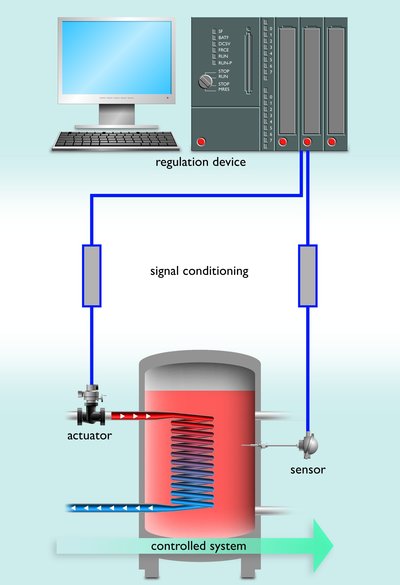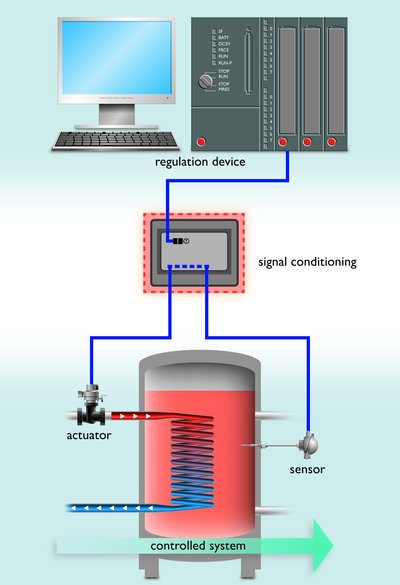Single loop integrity: replacing devices while operational
Friday, 16 March, 2012
Compared with parallel wiring, fieldbus systems have a negative impact on the availability of process-related plants and systems. This is because users have to isolate the entire bus segment from the network in order to, say, replace a defective component. On the other hand, scalable fieldbus couplers can now be simply hot-swapped. As a consequence, the single loop integrity proven for parallel wiring is now also possible for fieldbus systems.
In the past, plant and system designers could configure the control loops required for the application by referring to an engineering manual: a sensor acquires the actual value, which is then transferred to the control unit via a cable. In the control unit, the actual value is then compared with the set point and the actuating signal is transferred to the actuator via a second cable. The interfaces located between the sensors, actuators and controllers are used to appropriately adapt signals (Figure 1). All of the components can be simply and quickly replaced or expanded as each component of the control loop - including the interface - can be separately implemented. This secures a high degree of system availability.

However, this procedure has changed with the introduction of bus technologies such as Profibus PA or Foundation Fieldbus (FF). Whereas the principle of the controller compared with classic parallel wiring (4-20 mA technology) has been retained, the interface level has been modified (Figure 2).

Multichannel couplers require that numerous connections are kept as reserve
Application costs are reduced by using fieldbus technology in the planning and installation phase; however, at the same time the availability of process-related plants and systems has significantly decreased when it comes to fault tolerance. The first installation concepts employed a trunk cable that was routed from the control system into the field. Process instruments were then connected in parallel with one another using T elements. This meant that if a short circuit occurred, then communications in the complete bus segment failed. Later, segment protectors were available in the form of multichannel blocks. This means that the fault is limited to the particular spur line and the remaining segment remains functional. These blocks are available with outputs that limit the short-circuit current as well as provide intrinsically safe outputs, known as field barriers. In both versions, energy is transformed into heat, which in turn contributes to component ageing.
If a channel of the multichannel coupler is defective and has to be replaced, then during replacement the complete bus segment and thus the corresponding plant or system section are disconnected from the network. In the worst case, this means that the plant has to be shut down and then restarted. A simple network component can therefore cause expensive production downtimes.
Process plants are also regularly optimised and expanded over the course of their quite long life cycle. In some cases, it just involves providing an additional pressure, temperature or flow value at a certain location, or installing an additional valve. As a consequence, the multichannel blocks are designed so that approximately 25% of the connections are kept as reserve. This means that it is not certain as to whether these connections will ever be required, or will even function at all when the time comes to use them.
Scalable couplers permit planning and installation precisely as required
When using conventional coupler blocks, the uncertainties associated with fieldbus technology start in the planning phase and remain over the complete usage time all the way through to decommissioning.
Against this background, the design of conventional device couplers and field barriers has been investigated and improved, resulting in scalable couplers that combine the use of fieldbus technology with a high availability through single loop integrity. This means that devices can be planned and installed precisely as required and also flexibly replaced and expanded (Figure 3).

A main cable terminal connects the two-core Foundation Fieldbus or Profibus PA cable of the high power trunk to a mounting rail connector. The device couplers and the intrinsically safe fieldbus barriers receive the fieldbus signal via this backplane, limit it depending on the required type of protection according to Ex nA[ic]/FISCO ic or Ex nA [ia]/FISCO, and connect it to the field devices. Using this approach, the installation can be efficiently configured with a high associated degree of availability. During the planning phase, users only have to know approximately how many transmitters are required and where they should be located in the plant. On the basis of this information, users can decide on the dimensions of the required junction box, in which the required couplings are connected to the bus one after the other. The only reserve that users have to take into account is the space required on the mounting rail.
The junction box mounted in Zone 2 includes the main cable coupler, which opens the mounting rail bus and terminates the main cable. It is now possible to restrict the spur line connections to the number that is actually required. Nevertheless, users still have the security that they can subsequently add as many additional spur line connections as the mounting rail can accommodate. In this way, for example, an additional pressure transmitter can be easily installed. Every coupler has a mounting rail connector. While operational, the backplane can be expanded, the new coupler snapped onto the mounting rail and the transmitter connected. This ensures a high degree of availability of the plant and also allows the use of single loop integrity, which has been proven in parallel wiring designs. If a coupler is defective, then a user can remove it from the mounting rail and replace it without interrupting production.
Single loop integrity plays a role in achieving the required safety
In the years to come, Safety Stacks FF SIF (Safety Instrumented Functions) and Profisafe will also establish themselves in process technology. This involves safety protocols, which permit SIL3 implementation according to IEC 61508 using software. This has proved to be advantageous, because the processes running between the DCS and the field device do not have to be considered in the SIL assessment. In fact, the protocols ensure that all corrupted signals in the physical layer are reliably detected, therefore allowing the plant or system to be automatically brought into a safe state. However, when planning the invisible black channel, users do not have to depend on the certification of the protocol alone. They can also play their own role in achieving the demanded safety by incorporating the fieldbus power supplies and fieldbus couplers in their assessment. Because when all is said and done, what use is a protocol that reliably detects faults but cannot physically increase the availability of the plant? Neither FF SIF nor Profisafe are in a position to prevent having to isolate a segment from the network when replacing a defective fieldbus barrier block. Against this background, the scalable fieldbus couplers are well suited to continuous processes, no matter whether they involve standard or safety-relevant applications.
Conclusion
In addition to the efficient utilisation of the communication channel by the Foundation Fieldbus protocol expansion - Control In the Field (CIF) - not only are the response times of the system optimised, but when using scalable fieldbus couplers, hardware-based single loop integrity can also be achieved. In summary, it may be said that process plants and systems can be improved through software as well as through innovative mechanical designs.
Highly precise and safe control of hydrogen testing
With a modular control solution from Beckhoff featuring over 500 data points, Greenlight...
Three strategies that will enable IIoT deployment
A tech insider reveals how the food and beverage industry can take small, strategic steps forward...
Meaningful connections: connectivity challenges in Australia's process automation landscape
Increased connectivity is a pivotal factor in the future of process automation across Australia,...











